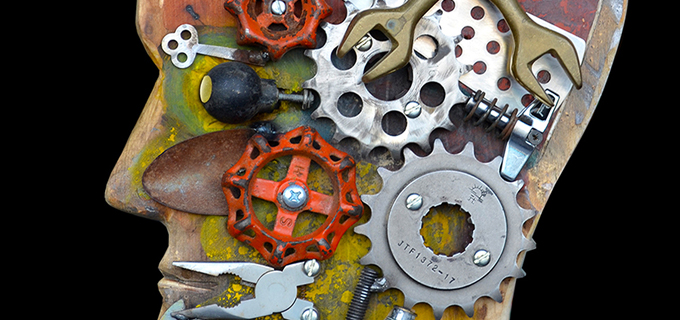“Art will remain the most astonishing activity of mankind born out of struggle between wisdom and madness, between dream and reality in our mind.”
–Magdalena Abakanowicz
Where does the impulse to create come from? Why did humans begin making art?
Ancient shamans and mystics would connect with their spiritual helpers and bring through their magic into signs and talismans that could be used by their people to access that power themselves. They may have used drawings or rudimentary carvings in rituals to control Nature and to commemorate or convey the past, recording it visually before written language existed. Making “art” was also a way of tapping into and becoming part of the beautiful process of creation that ancient peoples felt and saw all around them. Living by instincts, closer to the natural world as a way to survive, they were more in tune with this.
As human consciousness developed, art, music, and dance emerged as a similar, if more complex, means of expression. Graffiti is not too different from cave painting. Sculpture could be considered a form of talisman. Here are eight reasons why artists make art:
1. To connect with the viewer. Making art is a way of sharing emotions, memories and thoughts. No matter what medium is used to communicate– clay, paint, a photograph, or words on paper—the human experience underneath, we are all pretty much the same.
2. To tell a story that cannot be told with words. If words could be used to express what ancient peoples wanted to say, they would not have resorted to making images in paint, or wood, or stone. Even today, it’s said that a picture is worth a thousand words. The visual arts are a language expressed and perceived by different parts of the brain, and they have a different effect than words do on both the artist and the viewer.
3. To connect with something greater than themselves. For many artists, the process of creation is a way to connect with “God” through focused intention. They live to feel the force of creation move through them, expressing it as “art.”
4. To chronicle and celebrate beauty. The artist’s perspective of beauty often includes that which is not obvious. The uncommon or unusual sits alongside every day life or nature and this juxtaposition is fodder for the artist’s expression.
5. To demonstrate expertise with a medium. “The medium is the message,” said Marshall McLuhan, and this is often true for artists. There is much to explore in all artistic mediums, and many artists spend productive careers exploring only the mediums they use, whether it is re-purposed objects as in the work of Arman or, on a smaller scale, the work of Joseph Cornell.
6. To explore the elements of art. Line, shape, space, and color are waypoints that an artist connects with, explores, and re-discovers.
7. To innovate and break rules. As Pablo Picasso once said, “Learn the rules like a pro, so you can break them like an artist.” Artists make connections between seemingly unrelated observations and uncover unique perspectives. They are often innovators who push the boundaries of existing “rules” to go beyond them. This includes using technology and original materials to create what has not been created before.
8. To have fun. There is great pleasure in making something by hand and creating art is a form of play. Play inspires risk-taking, and experimentation, strengthening problem-solving skills and stimulating imagination. Play liberates the artist from the routine and confines of everyday life.
Here are some quotes by famous artists on why they make art, collected by artist Susie Gadea:
“If you could say it in words, there’d be no reason to paint.”
Edward Hopper
“People simply fail to understand that we paint in order to experiment and to develop ourselves as we strive for greater heights.”
Edvard Munch
“I don’t paint to live, I live to paint.”
Willem de Kooning
“If I didn’t think what I was doing had something to do with enlarging the boundaries of art, I wouldn’t go on doing it.”
Claes Oldenburg
“Art to me is a humanitarian act and I believe that there is a responsibility that art should somehow be able to have an effect on mankind and make the world a better place.”
Jeff Koons
“I want to touch people with my art. I want them to say ‘he feels deeply, he feels tenderly.”
Vincent Van Gogh
“The primary purpose of life is to achieve a growth of consciousness.”
Gordon Onslow-Ford
“Learning to trust my own creative process has been key to my artistic development, and I continue to learn with each new piece.”
Janyt Piercy-Brooks
“Getting into alignment with our truth is like opening the door to destiny.”
Linda Saccoccio
“All art deals with the absurd and aims at the simple. Good art speaks truth, indeed is truth, perhaps the only truth.”
Iris Murdoch
“I seek for neither the real or the unreal, but for the subconscious, the instinctive mystery of the human race.
Amedeo Modigliani
“I am for an art that is political-erotical-mystical, that does something other than sit on its ass in a museum.”
Georgia O’Keefe
“Every man who steeps himself in the spiritual possibilities of his heart is a valuable helper in the building of the spiritual pyramid which will someday reach to heaven.”
Wassily Kandinsky
“To send light into the darkness of men’s hearts, such is the duty of the artist.”
Robert Schumann
“As artists, we are educators and communicators. We need to keep our finger on the pulse of society.”
Elizabeth Azzolina
“In some ways I am a treasure hunter, searching for that perfect moment of order that sometimes occurs in the midst of chaos.”
Diana Lehr
“We just have to look and listen within, and be curious about our own experience.”
Brenda Johima
“My art is destined for the twenty-first century.”
Emma Kunz
